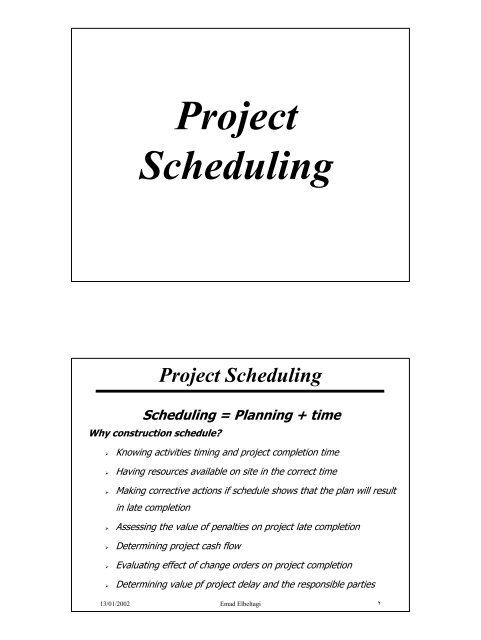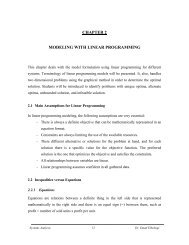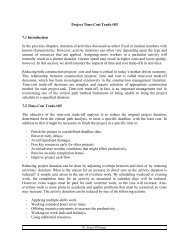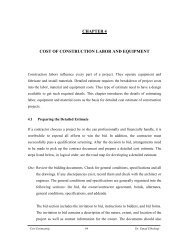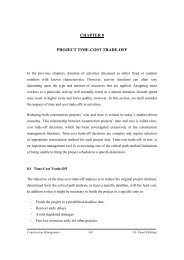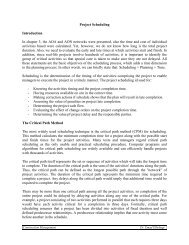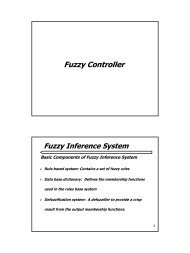Project Scheduling
Project Scheduling
Project Scheduling
You also want an ePaper? Increase the reach of your titles
YUMPU automatically turns print PDFs into web optimized ePapers that Google loves.
<strong>Project</strong><br />
<strong>Scheduling</strong><br />
<strong>Project</strong> <strong>Scheduling</strong><br />
<strong>Scheduling</strong> = Planning + time<br />
Why construction schedule<br />
‣ Knowing activities timing and project completion time<br />
‣ Having resources available on site in the correct time<br />
‣ Making corrective actions if schedule shows that the plan will result<br />
in late completion<br />
‣ Assessing the value of penalties on project late completion<br />
‣ Determining project cash flow<br />
‣ Evaluating effect of change orders on project completion<br />
‣ Determining value pf project delay and the responsible parties<br />
13/01/2002 Emad Elbeltagi ٢
<strong>Project</strong> <strong>Scheduling</strong><br />
The Critical Path Method (CPM)<br />
‣ Most Widely used method for project scheduling<br />
‣ Calculates the minimum completion time for a project<br />
‣ Calculates activities timings<br />
‣ Computer programs use CPM , handle large projects<br />
‣ Forward path<br />
‣ Backward path<br />
‣ Float calculations<br />
‣ Critical activates<br />
13/01/2002 Emad Elbeltagi ٣<br />
<strong>Project</strong> <strong>Scheduling</strong><br />
The Critical Path Method (CPM)<br />
What creates activities’ timings<br />
‣ Consider the example of traveling to Alex.<br />
‣ Travel to Cairo 2 hours at 10 AM<br />
‣ Meeting for 2 hours<br />
‣ Travel to Alex 3 hrs<br />
‣ Meeting for 2 hrs staring at 6 PM<br />
13/01/2002 Emad Elbeltagi ٤
<strong>Project</strong> <strong>Scheduling</strong><br />
1. CPM for Activity on Arrows<br />
ETi LTi<br />
i<br />
x<br />
dx<br />
ETj LTj<br />
j<br />
Forward path<br />
‣ ET for the first node = 0<br />
‣ ETj = ETi + dx<br />
‣ ESx = ETi<br />
‣ EFx = ESx + dx<br />
Backward path<br />
‣ LT for the last node = its ET<br />
‣ LTi = LTj - dx<br />
‣ LFx = LTj<br />
‣ LSx = LFx - dx<br />
13/01/2002 Emad Elbeltagi ٥<br />
<strong>Project</strong> <strong>Scheduling</strong><br />
1. CPM for Activity on Arrows<br />
ES = ETi ETj LF = LTj<br />
ES EF=ES+d Total Float<br />
d<br />
ES Total Float LS=LF-d LF<br />
d<br />
d<br />
Free Float (FF)<br />
Total time available for the activity = LF - ES<br />
‣ TF = LF – EF = LS – ES<br />
‣ FF = ETj – ETi – d<br />
= smallest ES (of succeeding act.) – EF (of current act.)<br />
13/01/2002 Emad Elbeltagi ٦
<strong>Project</strong> <strong>Scheduling</strong><br />
1. CPM for Activity on Arrows<br />
Critical activities & critical path<br />
‣ Activities with TF = 0 are critical<br />
‣ These activities need special attention during construction<br />
‣ A set of critical activities form a critical path<br />
‣ the critical path is a continuous path of critical activities<br />
‣ The critical path is the longest one in the network<br />
‣ More than critical path can be formed<br />
13/01/2002 Emad Elbeltagi ٧<br />
Example<br />
<strong>Project</strong> <strong>Scheduling</strong><br />
1. CPM for Activity on Arrows<br />
5<br />
B<br />
d1<br />
1<br />
3<br />
A C E<br />
3<br />
9<br />
d=3 4 5<br />
11<br />
D<br />
d2<br />
6<br />
7<br />
13/01/2002 Emad Elbeltagi ٨
<strong>Project</strong> <strong>Scheduling</strong><br />
2. CPM for Activity on Nodes (PDM)<br />
ESi EFi<br />
i (di)<br />
LSi LFi<br />
overlap ij<br />
ESj EFj<br />
j (dj)<br />
LSj LFj<br />
Forward path<br />
‣ ES for the first Activity = 0<br />
‣ EFi = ESi + di<br />
‣ ESj = EFi - overlapij<br />
Backward path<br />
‣ LF for the last activity = its EF<br />
‣ LSj = LFj - dj<br />
‣ LFi = LSj + overlapij<br />
13/01/2002 Emad Elbeltagi ٩<br />
<strong>Project</strong> <strong>Scheduling</strong><br />
2. PDM<br />
Example<br />
B (3)<br />
A (3)<br />
C (4) E (5)<br />
D (6)<br />
13/01/2002 Emad Elbeltagi ١٠
<strong>Project</strong> <strong>Scheduling</strong><br />
3. Time-Scaled Diagram<br />
‣ Activities are drawn to scale according to its duration<br />
‣ Relationships are represented using Horizontal or vertical lines<br />
‣ It can be drawn using calendar dates<br />
‣ Activities times can read directly form the chart<br />
‣ It can be used to calculate resource usage or cost<br />
1 2 3 4 5 6 7<br />
A<br />
C<br />
3 4<br />
B<br />
3 1<br />
13/01/2002 Emad Elbeltagi ١١<br />
<strong>Project</strong> <strong>Scheduling</strong><br />
3. Time-Scaled Diagram<br />
‣ A (3 days) has no predecessor<br />
‣ B (3 days), C (4 days), & D (6 days) depend on A<br />
‣ E ((5 days) depends on B, C, and D<br />
1 2 3 4 5 6 7 8 9 10 11 12 13 14<br />
B<br />
3<br />
A<br />
3<br />
C<br />
4<br />
D<br />
6<br />
E<br />
5<br />
13/01/2002 Emad Elbeltagi ١٢
<strong>Project</strong> <strong>Scheduling</strong><br />
Bar Chart (Gantt Chart)<br />
‣ Time versus activity chart<br />
‣ Simple representation and easy to read<br />
‣ Early bar chart<br />
Activity<br />
A<br />
B<br />
C<br />
D<br />
E<br />
d=3<br />
ES = 0 d=3 TF=3<br />
ES=3<br />
d=4 TF=2<br />
ES=3<br />
d=6<br />
ES=3<br />
ES=9<br />
d=5<br />
0 1 2 3 4 5 6 7 8 9 10 11 12 13 14 Time<br />
13/01/2002 Emad Elbeltagi ١٣<br />
<strong>Project</strong> <strong>Scheduling</strong><br />
Bar Chart (Gantt Chart)<br />
‣ It can use calendar dates<br />
‣ It can be drawn using late start times<br />
‣ Late start bar chart<br />
Activity<br />
A<br />
B<br />
C<br />
D<br />
E<br />
d=3<br />
LF=3 d=3<br />
d=4<br />
d=6<br />
LF=9<br />
LF=9<br />
LF=9<br />
d=5<br />
LF=14<br />
0 1 2 3 4 5 6 7 8 9 10 11 12 13 14 Time<br />
13/01/2002 Emad Elbeltagi ١٤
<strong>Project</strong> <strong>Scheduling</strong><br />
Bar Chart (Gantt Chart)<br />
‣ It can be used for resource and cost analysis<br />
13/01/2002 Emad Elbeltagi ١٥<br />
<strong>Project</strong> <strong>Scheduling</strong><br />
Criticism to Network Techniques<br />
‣ Duration driven schedule<br />
‣ Assumes resources are available<br />
‣ Can not deal with project deadline<br />
‣ Ignore project cost (minimum cost)<br />
‣ Use deterministic durations<br />
13/01/2002 Emad Elbeltagi ١٦


